What Causes a Coolant Leak & How Do You Fix It?
Seeing other fluids however such as oil or a green liquid can mean you have some leaking problems. In this article we will be looking at the green liquid and this would likely be coolant. We will learn more about coolant, what can cause a leak of this fluid, how it can be fixed and how much these repairs may be.
What Exactly Is Coolant?
Also known as Antifreeze, engine coolant fluid is essentially the sweat of the automotive vehicle in many respects. When we get too hot we perspire and this moisture on our skin cools us by using our body heat to evaporate.
Coolant acts in a similar way with the exception of the evaporation part. It moves around the engine in its own enclosed system and leeches the heat created by the combustion process. As the coolant circulates it collects the heat, cools the engine and eventually reaches the radiator where it can release the heat it gathered.
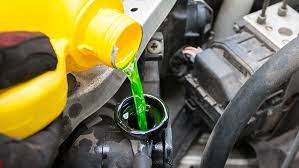
Coolant can do its job in all weathers from scorching heat to freezing cold. It doesn’t have to work quite as hard when it's cold but you do still need to cool your engine. The reason we use coolant and not just water is because normal water would freeze in cold conditions.
Engine coolant is a mixture of water, silica and ethylene glycol. As such it is formulated to work in all weathers and although some evaporation may occur over time it should largely remain in the coolant system. Signs of it outside of this system may indicate an issue and put your vehicle at risk of overheating.
Signs You Have a Coolant Leak
The cooling system is very important to the car but we often overlook it until things get noticeably bad. Car engines have a normal running temperature range so if your engine temperature gauge starts to creep above this range you may be experiencing issues.
If your engine temperature spikes high and will not come down you need to pull over and quickly check your coolant reservoir. This is usually very easy to find under the hood and often has visible fill markings to tell you if your coolant level is too low.
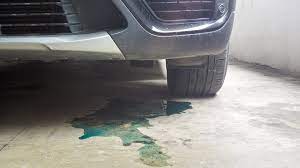
Make it a practice to have a spare bottle of coolant in the car in case you need to top up the coolant system. After topping up, check frequently to see if the level starts to decrease rapidly as this will indicate you have a leak.
A very obvious sign of a leak will be green fluid under the car in the region of the engine. There is no reason to see this green coolant on the ground under your car unless you have some form of leak.
What Might Cause a Coolant Leak?
The coolant system is not one of the most complex in the vehicle but there are still plenty of potential causes for a leak. This can range from faulty hoses to failing parts and can be noticeable in many cases but also harder to locate in others.
Hole in the Radiator
As mentioned after collecting the heat from the engine the coolant passes through the radiator where it itself is cooled back down before it goes back through the system again. The location of this part puts it under a lot of stress and at risk from corrosion over time.
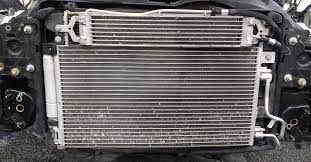
If you develop a hole in your radiator then coolant will start to leak out each time it passes through. You may also find that the sealing gasket between the radiator and the coolant tank can wear out. Without a good seal the coolant again can start to leak out.
A Leaky Radiator Cap
You may have seen in movies when a car overheats that the driver gets out and unscrews the radiator cap and the results are frankly scary. First off, never do this on a car that has been running because the coolant inside is under a lot of pressure and it is really hot.
The radiator is responsible for both keeping the coolant in the system but also containing the high pressure within the unit. When working correctly the cap contains all of this and creates a solid seal. Over time however this seal can deteriorate and as a result the high pressure coolant liquid can seep out around the edges.
Blown Head Gasket
You may have heard of the head gasket again possible in movies or on tv where it is often mentioned in scenes with mechanics. This is an important part of the car as its main purpose is to keep engine oil and coolant in their respective systems and not allow them to mix.
If the head gasket starts to leak however then these two liquids can find their way into each other's systems which in both cases is not good. Initially this will not be noticeable but eventually you will find that coolant is in the oil or oil is in the coolant.
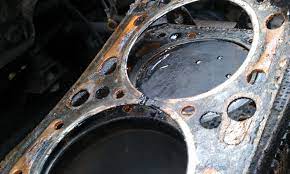
This will cause the engine to overheat until eventually the coolant starts to leak out of the engine as well. It left unrepaired; this will lead to major issues and potentially very costly repairs.
Failed Water Pump
This part is called a water pump but again the coolant in the system isn’t just water but is a well measured mixture of chemicals. Regardless, its job is to move the coolant around the cooling system and is prone to several potential problems that may cause coolant leaks.
Powered by the crankshaft by way of a belt, this belt can wear out causing issues. The part itself can also become corroded and develop leaks. External damage can also poke holes in the pump which will allow coolant to leak out.
Whatever the reason if your water pump is not able to function correctly you will get an overheated engine and this can cause big problems. If you can’t cool the engine then parts start to break and often repairs can be very expensive.
Expansion Tank
The coolant is kept in an expansion tank which you can easily locate under the hood next to your engine. As mentioned it often has fill level indicators and should be checked regularly. This plastic container holds the coolant as it waits to enter the system to be used.
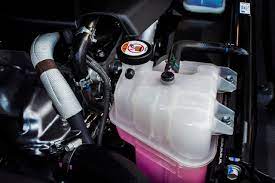
Over time this can wear out, plastic can crack or hoses can develop leaks. The rest of the system may still be well sealed but the expansion tank could be leaky and you will be losing the fluid directly to the ground below.
How Do You Fix Coolant Leaks?
The method you use to repair a coolant leak is going to depend on the issue so below we are going to give you some of the more common repairs. Some are a little unorthodox but still legitimate if not emergency short term fixes.
Use Eggs
This is one of those unorthodox repairs and really you should only pull this one out in a major emergency such as being stuck in the middle of nowhere. If you have a leaking radiator and happen to have a spare egg with you can crack the egg into the radiator.
The theory behind this short term fix is that the egg sinks to where the hole is, cooks under the engine's heat, and creates a seal. This may buy you enough time to get you somewhere more suitable where you can get the issue dealt with properly.
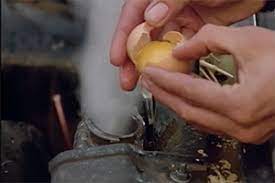
We must caution that this is not a permanent solution and should only be used in an emergency, The leak will have to be fixed permanently as soon as you can get this done.
If you are going to have to do this, allow your car to cool down first before opening the radiator cap. Start by cracking a couple of eggs into the radiator if this does not work you can add a couple more. Once the leak stops, top up your coolant and get yourself to a mechanic quickly. This does not hold for long.
Replace Hose Clamps
Sometimes the leak has developed because clamps have become corroded and are no longer keeping the hose clamped firmly to the connector. Replacing the clamp with a new one can reestablish the integrity of the connection and stop the leak.
As with all coolant system repairs make sure your car has cooled down before you start the repair. You may need to catch the coolant from the hose when you remove the old clamp so have a bucket ready. Replace the old clamp with a new one and tighten it in place. Refill your radiator with fresh coolant and hopefully you will be good to go.
Replace Hoses
If you have located the leaky hose and it is accessible then you can replace this with a new one. You may want to change the clamps at the same time even if they are not yet in too bad of a shape. As with the clamps only do these repairs on a car that has cooled down.
You may have to drain the coolant so have a bucket ready. Once the hose is replaced and the clamps retightened or also replaced you can go ahead and refill with fresh coolant. Run the car for a while and check to see if the leak has been fixed.
Replace the Radiator
If the radiator is beyond repair you are likely going to need to replace it. If you have the mechanical skills yourself then you can likely perform this. You will need the engine to be cooled down and to be able to remove the old part.
This will include draining the old coolant, disconnecting the hoses and unscrewing any holding bolts. Once the old part is out you will have to fit the new one. You will do everything you did to disconnect the old part but in reverse to connect the new one.
Once all hooked up you can refill the coolant and run the engine to test everything is connected and holding the fluid. Make sure you know the replacement process for your model of car and are confident to do this repair otherwise enlist a mechanic to help.
How Much Does It Cost to Fix a Coolant Leak?
There is a wide range of potential repair costs when it comes to a leaky coolant system meaning it can cost as little as $10 or over $3,000 depending on the problem. A new hose clamp may be very cheap and you can do this yourself.
Replacing the radiator can cost up to $1,200 depending on your car and the parts used while a head gasket can easily cost $2,000+ to fix.
The best advice we can give you is to keep a regular check on all your car fluid levels including coolant so you have an early warning of a problem. The quicker you fix this kind of issue the less it will cost you overall.
Conclusion
We underestimate coolant leaks but they can be a major issue. Without enough coolant our engine can overheat and quickly become damaged.
Link To or Reference This Page
We spend a lot of time collecting, cleaning, merging, and formatting the data that is shown on the site to be as useful to you as possible.
If you found the data or information on this page useful in your research, please use the tool below to properly cite or reference Tow Ratings as the source. We appreciate your support!
-
<a href="http://towratings.net/blog/what-causes-a-coolant-leak-how-do-you-fix-it/">What Causes a Coolant Leak & How Do You Fix It?</a>
-
"What Causes a Coolant Leak & How Do You Fix It?". Tow Ratings. Accessed on April 19, 2024. http://towratings.net/blog/what-causes-a-coolant-leak-how-do-you-fix-it/.
-
"What Causes a Coolant Leak & How Do You Fix It?". Tow Ratings, http://towratings.net/blog/what-causes-a-coolant-leak-how-do-you-fix-it/. Accessed 19 April, 2024
-
What Causes a Coolant Leak & How Do You Fix It?. Tow Ratings. Retrieved from http://towratings.net/blog/what-causes-a-coolant-leak-how-do-you-fix-it/.